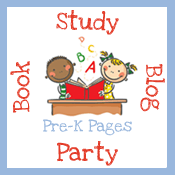I am thrilled to be participating in the Book Study Blog Party being hosted by Pre-K Pages. Each participating blogger is taking a turn to read a chapter of the book “Literacy Beginnings” by Gay Su Pinnell and Irene C. Fountas. You can check out the linky at the bottom of this post to see each chapter as it is posted by the bloggers or go to Pre-k Pages and follow along from there. Vanessa has already written her highlights for chapter one: Growing Up Literate so be sure to check out her enthusiastic and informative perspective.
Chapter Two: Building a Community of Learners
Chapter two of Literacy Beginnings, 2011, starts off with this thought provoking quote…
“Children learn and develop best when they are part of a community of learners – a community in which all participants consider and contribute to one another’s well being and learning”
~Carol Copple and Sue Bredekamp

I don’t know what the rest of this book has to say yet but already I am excited about it! With every word I read, I am nodding my head yes! If I could, I would just rewrite the whole chapter for you – it is that good! You do need to know, however, that this book is specifically targeting the prekindergarten classroom BUT this chapter can be applied to most, if not all, preschool age groups so stay with me whether you teach prekindergarten or not. Now let me share with you a few highlights from this chapter…
Support and Attention
Building a community of learners begins with the understanding that you will begin the year with children who come from all types of backgrounds and experiences. Some of your students will be shy and hesitant to participate while others will jump right in from the get go. In either case, your learners will need support and attention as they enter your classroom and begin the process of becoming a member of your learning community. As children feel accepted and a part of your learning community, they will begin to develop the skills they need to thrive in their future years of school.

Social Skills
A major part of building a community of learners is to help children manage social interactions and expectations. This can be done through positive modeling and attention as well as establishing structures and expectations that help children genuinely understand what they are to do. For example, the writers state, “When you are teaching children how to take turns in conversation, passing a soft physical object as a beanbag to hold when it is their turn to talk can be an effective and concrete reminder for young children who are often very literal-minded” (Ch. 2, pg. 30).
Creating Community
Establishing routines and creating a predictable daily structure is an important part of helping your student participate in the learning community. In addition, it is important to organize your materials and space so children can understand where things belong.

Getting the Community Started
It is important to spend the first few weeks of your school year “demonstrating, prompting, and reinforcing positive social interactions and conventions… A critical element of learning is self-regulation. Instead of continually saying “no” or correcting inappropriate behavior, consider modeling appropriate responses.” The authors describe several types of appropriate responses such as “showing the children how to stop and think about their behavior” and fostering positive classroom behavior by involving the children in making decisions or making up their own set of classroom rules (Ch 2, pg 31).

Circle Games
One of the most interesting parts of this entire chapter was how the authors identify circle gamesas being a critical aspect and major contributor towards building community. On page 33, the writers give an exhaustive list of twenty-five ways to use circle games to create community. Here are just a couple of those ideas…
- Have children walk around in a circle. Call out commands such as “tiptoe circle,” “marching circle,” “hopping circle.” (teach one action at a time).
- Walk in tight to make a small circle; then walk slowly backward to make the circle big (repeat).
(Chapter 2, pg. 33)
The writers also indicate that singing songs and acting out fingerplays is a great tool for creating community. One of my personal favorite circle songs/games is the busy bee game.
In a community of learners; classroom management is easier, children come to appreciate their differences, and children build skills of respect and collaboration they will use for a lifetime (Pinnell and Fountas).
I hope you have enjoyed this chapter of Literacy Beginnings. Coming up next is Scott from Brick by Brick! Be sure to check in tomorrow and see what Scott has to say about Chapter Three: Promoting Constructive Learning!
Available on Amazon











